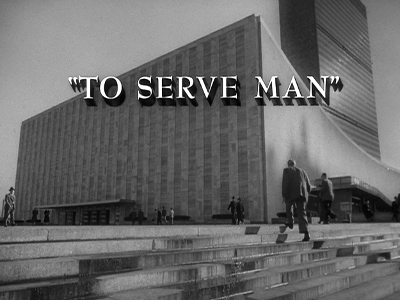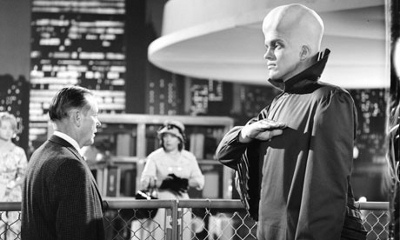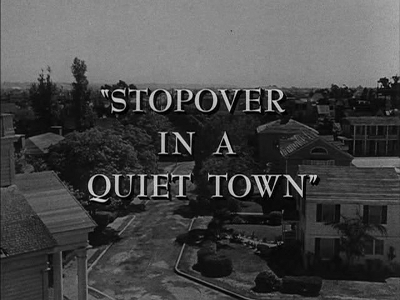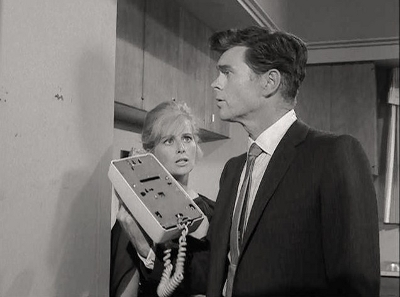|
Richard Kiel & Barry Nelson in The Twilight Zone

“You're
traveling through another dimension, a dimension not only of sight and
sound but of mind. A journey into a wondrous land whose boundaries are
that of imagination. That's the signpost up ahead - your next stop, the
Twilight Zone!”
The Twilight Zone ran from 1959
to 1964 for 156 episodes and remains an enduring icon in American
television history. It was created by Rod Serling - who also wrote many
of the episodes and appeared near the start to present an introduction
monologue to camera ("Submitted for your perusal...") and then ended
each episode with a closing piece of narration in his distinctive
manner and voice. The series was alternately spine chilling and
touching as each week a variety of characters took a wrong turn into
the Twilight Zone, a place where anything could and often did happen.
Serling was born in New York in
1924 and had a fairly extraordinary life until his premature death in
1975 from heart problems at the age of 50. Although a famously
diminutive man he was a paratrooper in World War 2 and fought in New
Guinea before taking part in the invasion of the Philippines (suffering
bad shrapnel wounds to a leg in the process).
After the war he enrolled in
Antioch College in Yellow Springs where the environment was a
lasting influence on him and the motto was 'Be ashamed to die until you
have won some victory for humanity' - a line which Serling later
incorporated into a touching Twilight Zone episode called The Changing
of the Guard with Donald Pleasance. While working nights for a radio
station after graduation, Serling furiously wrote during the day over
his kitchen table and eventually broke into television where he won
acclaim for his dramas Requiem for a Heavyweight and Patterns.
He was hailed as the new Arthur
Miller but Serling was frustrated by the conservative nature of
American television and felt constricted in his ability to address
social issues like injustice and racism. He discovered though that it
was perfectly possible to get scripts with controversial or political
subtexts past the censors if one disguised them in a science fiction or
fantasy setting. So was born The Twilight Zone, one of the most famous
and influential programmes in television history.
Serling wrote 99 out of the 156
episodes of The Twilight Zone and although he was always insecure about
his own achievements it's safe to say they were considerable and
timeless. In addition to Serling, the series had many episodes written
by talented people like Charles Beaumont, Richard Matheson and Earl
Hamner Jr and a host of actors who would become familiar names were on
the show. Robert Redford, Burt Reynolds, William Shatner, Charles
Bronson, Elizabeth Montgomery and so on.
The series had a sort of regular
company of actors who would frequently appear in different episodes.
Perhaps the two most cherished Twilight Zone stalwarts were Burgess
Meredith and Jack Klugman. You know it's going to be a good episode if
Jack Klugman is in it. We are going to look at two episodes featuring
Bond alumni though - if you can call Barry Nelson that. Well, he was
the first actor to play James Bond in 1954 in that Casino Royale curio.

“Respectfully
submitted for your perusal – a Kanamit. Height: a little over nine
feet. Weight: in the neighborhood of three hundred and fifty pounds.
Origin: unknown. Motives? Therein hangs the tale, for in just a moment,
we're going to ask you to shake hands, figuratively, with a Christopher
Columbus from another galaxy and another time. This is The Twilight
Zone.”
To Serve Man was directed by
Richard L Bare and written by Rod Serling. This is episode 24 of the
third series of The Twilight Zone and was first broadcast in 1962. To
Serve Man is one of the most famous Twilight Zone episodes and was
based on a story by Damon Knight. US government cryptographer Michael
Chambers (Lloyd Bochner) tells the extraordinary story of how he came
to be aboard an extraterrestrial spaceship - apparently being held
against his will but in relative comfort.
"This is the
way nightmares begin... or, perhaps, end. Very simple, direct,
unadorned. Incredible, and yet so terribly real that even while they're
happening we live with them, attest them, and assimilate them. And if
it's 12 o'clock noon, that's what you preoccupy yourself with. You
don't think about 12 o'clock noon on the next day or the day after
that. But that's what we should have been thinking about - tomorrow and
the day after tomorrow. We were preoccupied with hands on a clock...
when we should have been checking off a calendar..."
It all began when The Kanamits,
a race of nine-foot tall aliens, arrived on Earth offering friendship
and peace. The governments of Earth are rather suspicious at first but
Kanamit ambassadors visit the UN and pledge to share their technology
to make the world a better place. These alien visitors quickly make
good on their promises, transforming deserts into fertile fields,
ending hunger and supplying cheap and safe energy. They even set up an
exchange programme so people from Earth can visit their home planet -
which they promise is a paradise.
A book left at the UN by the
aliens is taken by US government cryptographers and the title is
eventually translated as 'To Serve Man'. It seems benevolent enough but
as they beaver away at translating the rest of the book a secret is
waiting to be revealed.
To Serve Man justifiably stands
as one of the most memorable Twilight Zone stories mainly because of
its wonderful shock ending - definitely one of the best twists in the
series. One thing I love is the team of US government cryptographers
who work at translating the book left by the aliens at the UN. It gives
the story here a wonderfully old-fashioned air of science doing its
level best to get to grips with something quite beyond anything it ever
expected to encounter - an alien language.
It's quite amusing in the United
Nations scenes the way that the French seemed to be the most obstinate
in not trusting the aliens. They always have to be different. I like
the way the story here here lulls you into a slightly false sense of
security but always keeps you aware that there are secrets waiting to
be uncovered.

Lloyd Bochner is suave as the
solid lead but it's Richard Kiel who really steals the show as the
Kanamit ambassador with a huge domed head prosthetic and flowing robes.
He is downright weird looking with spaced out eyes and that
unmistakable physical presence. His scenes at the UN are very striking
because he looks so out of place.
Kiel plays all of the Kanamits
you see in the episode and this tactic works quite well, giving them a
creepy uniformity. At the time Kiel was shooting a famously bad
(Mystery Science Theater 3000 lampooned) film called Eegah where he
played a caveman. He was allowed to take a week off from the caveman
shenanigans to shoot To Serve Man.
To Serve Man has a great
atmosphere with the black and white and stunning music cues from Jerry
Goldsmith. I believe the alien saucer section in the episode is from
Forbidden Planet and some stock footage from The Day the Earth Stood
Still was used to depict the Kanamits arriving. The classic fifties
sci-fi trappings are fun.
Serling apparently insisted on
reshoots after being unhappy with the initial cut and also inserted the
flashback structure at a later date. His revisions obviously worked as
this is considered to be a classic now. It all builds to the most
oft-quoted line in Twilight Zone history and a darkly amusing coda by
Rod Serling. To Serve Man is fantastic.

“Bob and
Millie Frazier, average young New Yorkers who attended a party in the
country last night and on the way home took a detour. Most of us on
waking in the morning know exactly where we are; the rooster or the
alarm clock brings us out of sleep into the familiar sights, sounds,
aromas of home and the comfort of a routine day ahead. Not so with our
young friends. This will be a day like none they've ever spent – and
they'll spend it in the Twilight Zone.”
Stopover in a Quiet Town is
episode 30 of the the fifth and final season of The Twilight Zone and
was first broadcast in 1964. It was written by Earl Hamner Jr (of later
Waltons fame) and directed by Ron Winston. Although Hamner was one of
the more whimsical writers on the show, Stopover in a Quiet Town is one
of the creepiest of the later Twilight Zone episodes.
The story has a well heeled New
York couple - Bob (Barry Nelson) and Millie (Nancy Malone) Frazier -
groggily waking up in a strange house after a night of heavy drinking.
They have no idea where they are or what exactly happened the previous
evening, only that they remember a huge shadow appearing over their car
at one point but their memories are fogged. They find the house they've
woken up in is completely empty. Even stranger is the discovery that
the house is filled with fake props like a television studio set.
The cupboards are just glued on
and the fridge is full of plastic replica food. The bewildered couple
wander outside and find themselves in a small town that seems to be
completely deserted. Where is everybody? Why does the grass seem to be
made of papier-mâché? And why do they keep hearing a little girl
laughing in the distance?
What the story does very nicely
here is set up a strange and intriguing mystery that slowly unravels as
the characters get closer and closer to the shocking secret of the
town. The twist is enjoyably far out (but very Twilight Zone) and it
was borrowed in fairly shameless fashion for a great episode of Hammer
House of Mystery and Suspense many years later. The couple in the story
are streetwise New Yorkers who have just had far too much to drink
during a raucous night out and are most concerned now with the fact
that they going to be late for work.
Problems soon arise though
because they've got no idea where they are and they can't find a single
solitary soul anywhere. Knocks on doors are met with silence and even
when they presume everyone must in the town church for some sort of
service they find that completely empty too. "Give me the big city any
day!" says Bob. "At least then you know you're being stared at!"

This is one of those Twilight
Zones stories that uses isolation and a gradual sense of panic to
create a very atmospheric and strange story. The fact that the couple
are quite ordinary and gently bickering with throbbing hangovers makes
them easy to relate to and imagine what it might be like to be their
predicament.
There are some elements of that
David Fincher film The Game here when they find out that the house they
are in is full of fake props and the story really becomes gripping when
they find that any attempts to leave the town always appear to be
doomed. The cars in the street don't have any engines and when they -
with great initial relief - find a train station and hop on a waiting
train, it only takes them around in a complete circle back to where
they started.
The sense of atmosphere in
Stopover in a Quiet Town comes from the fact that the town is eerily
empty and abandoned with only a sense of stillness and quiet apparent.
The spooky thing is that the town seems normal on the surface with no
sign or panic or flight, it's just empty. Isolation was often used to
good effect in the series (Where is Everybody?, The Lonely) and
Stopover in a Quiet Town is another example of this recurring theme.
The two leads do a perfectly
decent job here in their respective roles as their bicker, trade quips,
and generally try to work out what is going on. You believe in them as
a couple and Nelson and Nancy Malone have good chemistry togther. It
isn't regarded to be a classic and some might roll their eyes at the
twist but I had a lot of fun with Stopover in a Quiet Town. If you ever
plan a Twilight Zone retrospective I'd happily recommended both this
and To Serve Man as candidates.
- Jake
c 2016
Alternative 007
|

|


